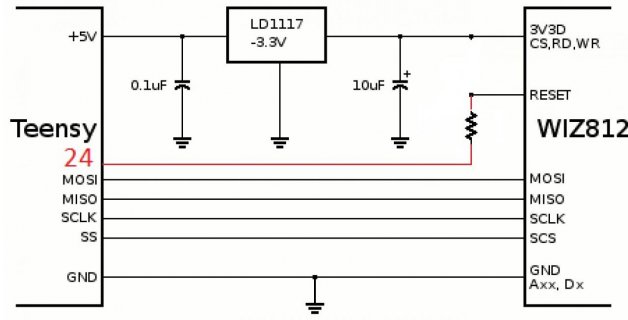airpanther
Active member
Good day,
I'm running a Teensy 3.5 with a W5500, and it communicates with other network devices very well! About 80% of the time, everything boots up perfectly, the board gets an IP address, and communications work perfectly. But about 1 in every 5 times of powering up the board, the W5500 module will fail with the same light pattern. The red light will light for about a half a second, then the green light for a split second, then both lights extinguish. About 3 seconds later, the same pattern happens again. This happens over and over again. However, once power to the board is cycled, everything boots up and works perfectly.
Any idea what I'm doing wrong?
Pin 2 below is the reset pin. 1,3,4,5 are the MOSI, MISO, SCLK and SS and are connected to the Teensy.

Here is the code I'm using to initialize the board. When the board fails, the code doesn't seem to get past this point
I'm running a Teensy 3.5 with a W5500, and it communicates with other network devices very well! About 80% of the time, everything boots up perfectly, the board gets an IP address, and communications work perfectly. But about 1 in every 5 times of powering up the board, the W5500 module will fail with the same light pattern. The red light will light for about a half a second, then the green light for a split second, then both lights extinguish. About 3 seconds later, the same pattern happens again. This happens over and over again. However, once power to the board is cycled, everything boots up and works perfectly.
Any idea what I'm doing wrong?
Pin 2 below is the reset pin. 1,3,4,5 are the MOSI, MISO, SCLK and SS and are connected to the Teensy.

Here is the code I'm using to initialize the board. When the board fails, the code doesn't seem to get past this point
Code:
void InitializeComms()
{
// start the Ethernet connection:
int iLoop = 0;
while (iLoop == 0) // Keep trying forever until a MAC address is received
{
if (Ethernet.begin(myMac) == 0)
{
Serial.println("Failed to configure Ethernet using DHCP trying again");
}
else
iLoop = 1;
}
Udp.begin(UDPPort);
}

